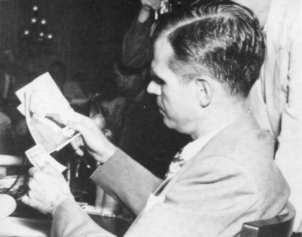A
succinct synopsis of the Hiss case from Hiss's coram nobis
petition
On
August 3, 1948, Whittaker Chambers testified at a hearing
of the House Un-American Activities Committee that Alger Hiss,
while he was a government employee, had been a member of an
"underground" group of the Communist Party from 1934 to 1937.
At the time Chambers made his charges, Hiss was president
of the Carnegie Endowment for International Peace, after having
rendered distinguished service to the government. His career
in the State Department and his close association with the
Yalta Conference and the United Nations, made him a prominent
target for the anti-Truman forces. His conviction quickly
became a political issue and, for some, a political bonanza.
(As a result of the Hiss-Chambers
investigation, HUAC member Richard M. Nixon, then an unknown
freshman Congressman from California, became a national figure.)

Alger
Hiss examines photos of Whittaker Chambers at a
televised
HUAC hearing on August 25, 1948.
Hiss
responded to the Chambers charge by requesting an opportunity
to appear before the Committee. He did so on August 5th. He
denied knowing a man named Whittaker Chambers but, at a later
session, confronted Chambers and identified him as a freelance
journalist he had known casually from about 1934 to 1936 by
the name of "George Crosley." Hiss denied he had
ever been a member of the Communist Party. When Chambers repeated
his charges outside the privileged area of the House Hearings,
Hiss sued him for libel in the United States District Court
for the District of Maryland.
Up
to this point, Chambers had made no claim in his several appearances
before the House Committee (or in his many interviews with
the FBI) that any government documents had been given to him
by Hiss. On the contrary, in his appearance on
October 14 and 15, 1948 before
a federal grand jury looking in to possible communist subversion
and violation of espionage laws, he testified that he had
no knowledge of any government employee furnishing information
to the Communist Party.
In
the pre-trial proceedings in the libel suit, Chambers was,
on November 4 and 5, 1948, called upon by Hiss' counsel to
produce any papers he might have received from Hiss. On November
17, 1948, he produced four penciled memoranda in Hiss's handwriting,
allegedly relating to State Department business, and 65 typewritten
pages. The latter purported to be copies of, or summaries
of, 43 State Department communications which were, according
to Chambers, given to him by Hiss between January 1, 1938
and about April 15, 1938. These papers became known as the
"Baltimore Documents."
|
|
|
Richard
M. Nixon examines "Pumpkin" films for the
press.
|
On
December 2, 1948 Chambers delivered
to the House Committee two strips of developed film and three
undeveloped rolls of film. The developed film contained pictures
of government documents that Chambers said he had received
from Hiss.The films became known as "the Pumpkin Papers,"
because Chambers had hidden them in a pumpkin prior to delivery
to Committee agents. The production of these papers and film
resulted in Chambers being called back before the grand jury
then sitting in the Southern District of New York. The panel
was conducting an investigation into the possible violation
of the espionage laws. Hiss appeared willingly before that
same grand jury to respond to Chambers' charges. He testified
on seven or eight occasions from December 7th to December
15, 1948. On the latter date, which was the last day of the
life of the grand jury, an indictment against him for perjury
was voted immediately after his final testimony.
The
indictment was in two counts. The first count alleged that
he had testified falsely when he stated that he had not turned
over to Whittaker Chambers any secret, confidential or restricted
documents, whereas in fact he had given such documents to
Chambers in February and March, 1938.
The
second count alleged that he had testified falsely when he
said that he thought he could definitely say that he had not
seen Chambers after January 1, 1937, whereas in fact he had
seen and conversed with Chambers in and about February and
March, 1938. After the usual pre-trial proceedings, the case
came on for trial before Judge Samuel H. Kaufman and a jury
on May 31, 1949. It ended in a mistrial on July 8, 1949 when
the jury was unable to agree on a verdict. A second trial
before Judge Henry W. Goddard and a jury began on November
17, 1949. Whittaker Chambers was the prosecution's principal
witness and the only witness as to many of the accusations
sought to be proved. The following is the substance of Chambers'
testimony at the second trial:
In
1934, Chambers was in Washington, D.C. as a member of a Communist
Party "underground" and in that capacity first claimed to
have met Hiss at a "restaurant in downtown Washington." The
introduction was allegedly effected by Harold Ware, who was
described as the organizer of a Communist underground apparatus
in Washington, and by J. Peters, who was described as the
head of the underground of the American Communist Party. Chambers
testified that at the meeting it was agreed that Hiss was
to be disconnected from the apparatus of which Ware was then
organizer and to become a member of a parallel organization
which Chambers was then organizing. He was introduced to Hiss
as "Carl." This meeting, said Chambers, marked the beginning
of a close association between Chambers and Hiss, both on
a social level and as Communist espionage agents - an association
which he said lasted for about four years.
continue
|

